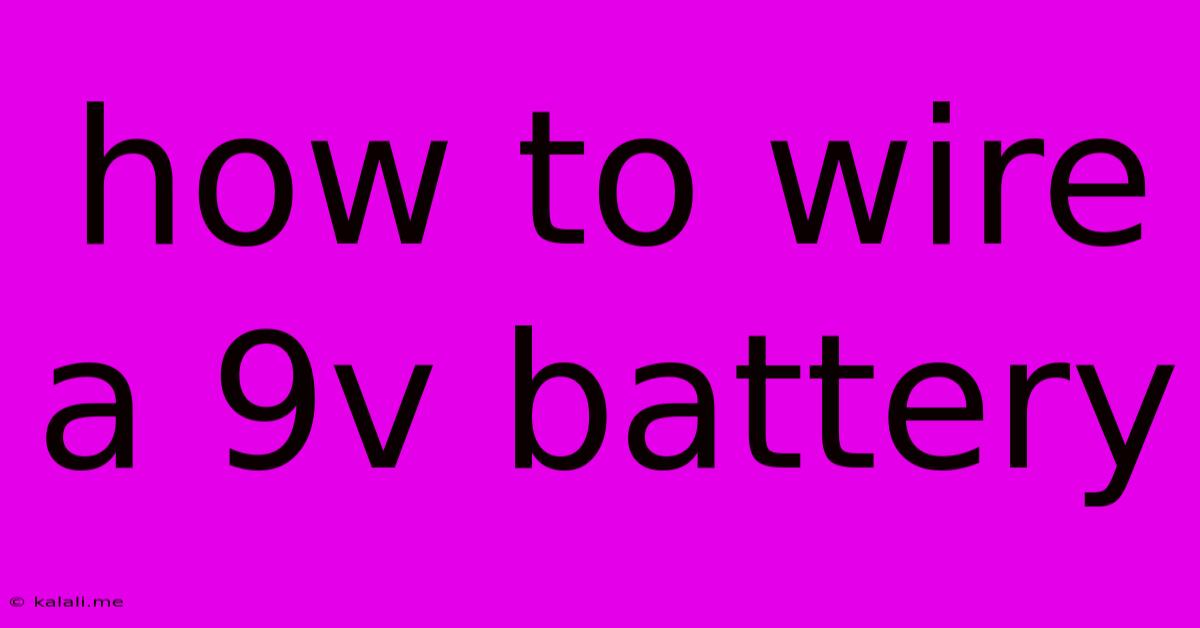How To Wire A 9v Battery
Kalali
Jun 02, 2025 · 3 min read

Table of Contents
How to Wire a 9V Battery: A Simple Guide
Wiring a 9V battery might seem intimidating at first, but it's a surprisingly straightforward process. This guide will walk you through the steps, explaining the basics of battery terminals and providing tips for safe and successful wiring. This is crucial for powering small electronics projects, and understanding the process will empower you to build and repair various circuits.
Understanding the 9V Battery
A standard 9V battery is rectangular with two terminals: a positive (+) and a negative (-). The positive terminal is usually located on the center connector, while the negative is the metal casing surrounding it. It's essential to identify these correctly before attempting any wiring to avoid short circuits and potential damage to your components. Accurate identification of the positive and negative terminals is paramount for the proper functioning of your circuit.
Materials You'll Need
Before you begin, gather these essential materials:
- 9V Battery: This is the power source for your project.
- Wires: Use insulated wires appropriate for the current your circuit requires. Consider the gauge of the wire based on the amperage draw of your project. Thicker wires are better for higher current applications.
- Connectors (optional): Connectors like alligator clips or solder can make wiring easier and more secure. Consider using crimp connectors for a more professional finish.
- Multimeter (optional): A multimeter can verify the voltage of your battery and ensure proper connections.
Steps to Wire a 9V Battery
-
Identify the Terminals: Locate the positive (+) and negative (-) terminals on your 9V battery.
-
Prepare Your Wires: Strip a small amount of insulation from both ends of each wire you'll be using. Be careful not to nick the wire itself. Stripping too much insulation can lead to shorts. The amount of insulation you need to strip depends on the type of connector you are using.
-
Connect the Wires: Securely connect one wire to the positive (+) terminal and the other to the negative (-) terminal. If using alligator clips, simply clamp them onto the terminals. If soldering, apply a small amount of solder to each connection, ensuring a secure bond.
-
Test the Connection (Optional): If you have a multimeter, test the voltage across the wires to confirm you have a 9V reading. This verifies a proper connection and confirms that the battery is functioning correctly.
-
Connect to Your Device: Once you've made your connections, carefully connect your wires to your device's power input. Ensure you connect the positive wire to the positive terminal of your device and the negative wire to the negative terminal. Failure to do so can damage your device.
Safety Precautions
- Avoid Short Circuits: Never allow the positive and negative terminals to touch each other directly. This can create a short circuit, potentially causing damage to the battery or even a fire.
- Proper Insulation: Ensure all wire connections are properly insulated to prevent accidental shocks or short circuits.
- Use Appropriate Gauge Wire: Using wire that is too thin can overheat and cause a fire.
- Dispose of Batteries Properly: Once your battery is depleted, dispose of it according to local regulations.
By following these simple steps and taking the necessary safety precautions, you can successfully wire a 9V battery and power your electronic projects. Remember to always double-check your connections before applying power to your device to prevent damage. Mastering this skill opens up a world of possibilities for electronic projects and circuit construction.
Latest Posts
Latest Posts
-
Residuals Vs Fitted Plot In R
Jun 04, 2025
-
Could The World Exist Without Randomness
Jun 04, 2025
-
2 Wire Romex Lightswith And Plug
Jun 04, 2025
-
Painting Of Tony Soprano With Horse
Jun 04, 2025
-
Would A Gun Work In Space
Jun 04, 2025
Related Post
Thank you for visiting our website which covers about How To Wire A 9v Battery . We hope the information provided has been useful to you. Feel free to contact us if you have any questions or need further assistance. See you next time and don't miss to bookmark.